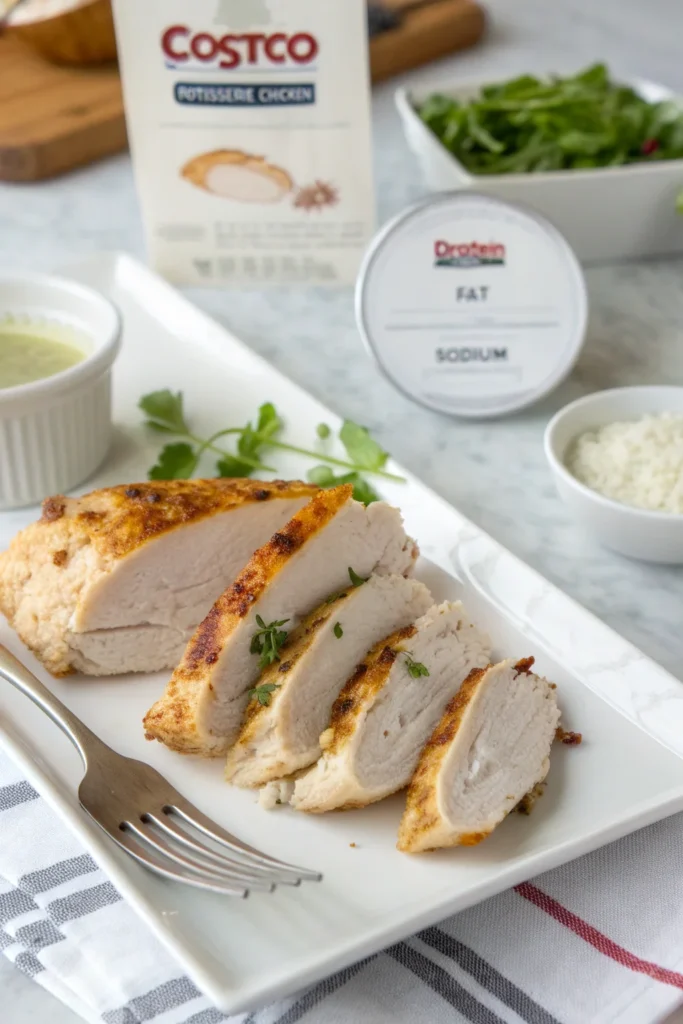Introduction
Costco’s rotisserie chicken has gained a cult-like following for being affordable, convenient, and delicious. But while many love its crispy skin and tender meat, others question whether it’s actually a healthy choice. The big questions remain: Are Costco rotisserie chickens healthy? Do they contain harmful additives? Is their high sodium content a cause for concern?
In this article, we’ll break down the nutrition facts, ingredients, health benefits, and risks of Costco’s famous rotisserie chicken. We’ll also compare it to other grocery store options, explore expert opinions, and provide healthier alternatives. By the end, you’ll have all the information you need to decide whether this popular store-bought chicken belongs on your plate.
Learn why athletes love rice cakes as a post-workout snack and how they aid in recovery.
Let’s start by understanding what makes Costco rotisserie chicken so popular and whether its nutritional profile supports a balanced diet.
Understanding Costco Rotisserie Chicken
What Makes Costco Rotisserie Chicken Popular?
Costco’s rotisserie chicken isn’t just another grocery store staple—it’s a go-to meal for thousands of shoppers. But why is it so popular?

Affordability and Convenience
One of the biggest selling points of Costco’s rotisserie chicken is its low price. At just $4.99, it’s one of the cheapest ready-to-eat meals available. Unlike fast food, it provides a solid source of protein without breaking the bank. Plus, it’s fully cooked, making it a hassle-free option for busy families.
High Demand Among Consumers
Shoppers love Costco’s rotisserie chicken because of its consistency in taste and quality. Every bird is seasoned, slow-roasted, and perfectly golden-brown, offering a juicy, flavorful meal. Costco even keeps the price low by selling it as a loss leader, drawing customers into the store.
Nutritional Overview of Costco Rotisserie Chicken
If you’re wondering, “Are Costco rotisserie chickens healthy?”, the answer depends on what you’re looking for nutritionally. Let’s break it down.
Calories, Protein, and Fats Breakdown
A 3-ounce serving of Costco’s rotisserie chicken contains approximately:
| Nutrient | Amount |
|---|---|
| Calories | 140 kcal |
| Protein | 22g |
| Total Fat | 7g |
| Saturated Fat | 2g |
This means that more than half of the calories come from protein, making it a good source of muscle-building nutrients. The fat content is moderate, with only 2g of saturated fat per serving, making it a relatively healthy choice—at least at first glance.
Sodium and Other Additives
Here’s where things get tricky. Each 3-ounce serving of Costco rotisserie chicken contains 460mg of sodium, which is one-fifth of the recommended daily intake. If you eat more than one serving—or consume the skin—you’ll be taking in even more sodium.
The chicken is also seasoned with phosphates and preservatives, which help maintain moisture and flavor. While these additives aren’t necessarily dangerous, high consumption of sodium and phosphates has been linked to high blood pressure and kidney issues.
Key Takeaways from Part 1
- Costco rotisserie chicken is cheap, convenient, and high in protein.
- One serving contains 140 calories, 22g of protein, and 7g of fat.
- It has 460mg of sodium per serving, which may be too high for some diets.
- It contains phosphates and preservatives to enhance flavor and shelf life.
Discover the benefits of eating rice cakes after exercise to refuel your body and boost energy levels.
Ingredients and Additives in Costco Rotisserie Chicken
When considering “are Costco rotisserie chickens healthy?”, it’s essential to look beyond calories and protein. The ingredients and additives used to season and preserve the chicken play a crucial role in determining its health impact. While Costco’s rotisserie chicken is flavorful, it contains more than just natural spices. Let’s break down what’s inside.
Common Ingredients Used in Costco Rotisserie Chicken
To keep their rotisserie chicken moist and flavorful, Costco adds a mix of seasonings and preservatives. But what exactly is in that seasoning blend?
Phosphates and Their Role
One controversial ingredient found in Costco’s rotisserie chicken is sodium phosphate. It helps retain moisture, making the chicken juicy even after sitting in a heated display case for hours. However, excessive phosphate intake has been linked to:
- Kidney issues – Phosphates can accumulate in the blood, putting extra strain on the kidneys.
- Bone health concerns – High phosphate levels may reduce calcium absorption, potentially weakening bones over time.
Preservatives and Flavor Enhancers
Costco also uses modified food starch, carrageenan, and sugar to enhance flavor and texture. While these additives aren’t considered highly dangerous, they may cause digestive issues in people with sensitivities.
- Modified food starch – Often used as a thickener, but some types contain gluten.
- Carrageenan – A seaweed-derived thickener that some studies suggest may cause inflammation.
- Added sugars – Minimal but present, contributing to hidden calorie intake.
Are These Additives Harmful to Health?
Now that we know what’s inside Costco’s rotisserie chicken, the big question is—are these additives safe to eat?
Potential Health Risks
For most people, eating rotisserie chicken occasionally won’t cause major health problems. However, regular consumption of high-phosphate and high-sodium foods may increase the risk of:
- High blood pressure – Due to excessive sodium intake.
- Heart disease – A diet high in processed meats and preservatives has been linked to cardiovascular issues.
- Kidney strain – Those with kidney disease should be cautious about sodium and phosphate consumption.
FDA and Health Regulations
While the FDA approves phosphates and preservatives in food, nutritionists warn that processed foods often contain higher-than-recommended amounts. The key is moderation—eating Costco rotisserie chicken occasionally is fine, but relying on it daily may not be the healthiest choice.
Takeaway from Part 2:
- Costco’s rotisserie chicken contains sodium phosphate, modified food starch, carrageenan, and added sugars.
- These additives help with moisture retention and flavor but may cause health concerns in excessive amounts.
- People with high blood pressure, kidney disease, or sensitivities to additives should be cautious.
Learn more about the nutritional breakdown of Costco rotisserie chicken to understand its calorie, protein, and sodium content.
Comparing Costco Rotisserie Chicken with Other Brands
You may wonder, “Are Costco rotisserie chickens healthy compared to other grocery store options?” After all, many supermarkets sell pre-cooked rotisserie chickens. Let’s take a closer look at how Costco stacks up.
How Does Costco Compare to Other Grocery Store Rotisserie Chickens?
While Costco’s rotisserie chicken is widely loved, it isn’t the only option. Many competitors, such as Walmart, Sam’s Club, and Whole Foods, offer their own versions. But how do they differ nutritionally?
Sodium and Additive Differences
| Store | Calories (3 oz) | Sodium | Additives |
|---|---|---|---|
| Costco | 140 | 460mg | Sodium phosphate, modified food starch, carrageenan |
| Walmart | 170 | 690mg | High sodium content, MSG |
| Sam’s Club | 160 | 550mg | Sodium phosphates, sugar, MSG |
| Whole Foods | 120 | 300mg | Organic, no preservatives |
- Walmart’s rotisserie chicken contains significantly more sodium and includes MSG, which some people prefer to avoid.
- Sam’s Club chicken is higher in sodium and sugar than Costco’s.
- Whole Foods’ rotisserie chicken is lower in sodium and contains no artificial preservatives, making it a healthier alternative.
Flavor and Texture Variations
While Costco’s rotisserie chicken is juicy and flavorful, it achieves this with sodium and phosphates. Whole Foods’ version, while healthier, may taste drier due to the lack of additives. Walmart and Sam’s Club versions are often saltier and sometimes include MSG for extra umami flavor.
Is It a Better Alternative to Fast Food?
Many people grab a Costco rotisserie chicken as a quick meal replacement. But how does it compare to fast food?
Nutritional Benefits Compared to Fried Chicken
| Food | Calories | Protein | Sodium | Fat |
|---|---|---|---|---|
| Costco Rotisserie Chicken (3 oz) | 140 | 22g | 460mg | 7g |
| KFC Original Recipe Chicken Breast | 390 | 39g | 1130mg | 21g |
| McDonald’s McChicken | 400 | 14g | 560mg | 21g |
Compared to fast food, Costco’s rotisserie chicken is:
✔ Lower in calories than fried chicken.
✔ Higher in protein per serving.
✔ Has much less fat than deep-fried options.
Cost vs. Health Benefits
A Costco rotisserie chicken costs $4.99, while a typical fast-food meal costs $7-$10. From a price standpoint, Costco’s chicken is a better deal than processed fast food. However, making a homemade roasted chicken with fresh ingredients could be the best choice for those prioritizing health.
Key Takeaways from Part 3:
- Costco’s rotisserie chicken has less sodium than Walmart’s or Sam’s Club’s but more than Whole Foods’ version.
- It’s a better option than fried fast food due to lower calories and fat.
- Whole Foods offers a healthier, preservative-free alternative, but at a higher price.
Potential Health Benefits of Costco Rotisserie Chicken
While some people worry about sodium and additives, others appreciate the nutritional value that Costco rotisserie chicken provides. But are Costco rotisserie chickens healthy when eaten as part of a balanced diet? Let’s explore the benefits.
Nutritional Advantages of Eating Rotisserie Chicken
If you’re looking for a quick, high-protein meal, Costco’s rotisserie chicken offers several advantages.
Lean Protein and Muscle Health
Each 3-ounce serving of rotisserie chicken provides:
- 22 grams of protein, which supports muscle growth and repair.
- Essential amino acids, helping with tissue recovery and immune function.
Compared to processed meats like bacon or sausage, rotisserie chicken is a leaner, lower-fat option. It’s also much lower in trans fats, making it a healthier alternative to fried foods.
Essential Vitamins and Minerals
Costco’s rotisserie chicken isn’t just about protein—it also delivers key vitamins and minerals:
| Nutrient | Benefit |
|---|---|
| B Vitamins (B3, B6, B12) | Supports brain function and energy production |
| Selenium | Boosts the immune system and protects cells |
| Phosphorus | Strengthens bones and teeth |
With its well-rounded nutrient profile, rotisserie chicken is a better choice than highly processed meats, especially when paired with veggies and whole grains.
How to Incorporate It into a Healthy Diet?
Eating Costco rotisserie chicken in moderation can be a nutritious option when paired with the right sides and preparation methods.
Best Ways to Serve and Pair It
To make your meal healthier, avoid eating just the chicken skin, which contains most of the added sodium and fat. Instead, try these combinations:
✔ With steamed vegetables – Balances the sodium with fiber and antioxidants.
✔ Over a quinoa or brown rice bowl – Adds complex carbs for sustained energy.
✔ In a salad with olive oil dressing – Provides protein without extra preservatives.
Low-Sodium Alternatives
Since Costco’s rotisserie chicken has a higher sodium content, you can make it healthier by:
- Removing the skin before eating.
- Pairing it with low-sodium side dishes.
- Drinking more water to help flush excess sodium from your body.
Key Takeaways from Part 4:
- Costco rotisserie chicken is high in protein and contains important vitamins and minerals.
- Eating it with nutrient-dense sides can make it a healthier meal.
- Removing the skin helps lower sodium and fat intake.
Looking for a light yet effective recovery snack? Check out why rice cakes are great post-workout for muscle recovery and endurance.
The Downsides of Costco Rotisserie Chicken
While Costco’s rotisserie chicken has its perks, it isn’t perfect. For some, the high sodium content and additives raise health concerns. So, are Costco rotisserie chickens healthy when eaten too often? Let’s dive into the downsides.
High Sodium Content and Health Risks
One of the biggest health concerns surrounding Costco’s rotisserie chicken is its high sodium content.
Impact on Blood Pressure
With 460mg of sodium per 3-ounce serving, just two servings can make up nearly half of the daily sodium limit for an adult. High sodium intake has been linked to:
- Increased blood pressure, which raises the risk of heart disease.
- Water retention, leading to bloating and swelling.
- Higher risk of stroke and kidney damage over time.
People with high blood pressure or heart disease should be especially cautious about how often they consume Costco’s rotisserie chicken.
Risks for People with Kidney Issues
Since the chicken contains sodium phosphate as a preservative, those with kidney disease or at risk for kidney problems should limit their intake. Excess phosphates can:
- Weaken bones by reducing calcium absorption.
- Cause kidney strain, making it harder for the body to process waste.
If you have kidney concerns, choosing a lower-sodium chicken option may be a smarter choice.
Processing and Ethical Concerns
Apart from sodium and preservatives, some consumers question the ethical and environmental impact of Costco’s chicken.
Factory Farming and Animal Welfare
Costco sells millions of rotisserie chickens each year. To meet demand, the company has built large-scale poultry farms, raising concerns about:
- Overcrowding and poor living conditions for chickens.
- Use of antibiotics to prevent disease in confined spaces.
- Environmental impact of mass chicken farming.
Advocacy groups argue that factory-farmed chicken production contributes to pollution and animal welfare issues.
Antibiotics and Hormones in Poultry
Although Costco claims its chickens are raised without added hormones, they may still receive antibiotics to prevent disease. While the USDA regulates antibiotic use, excessive antibiotic consumption in meat products could contribute to antibiotic resistance in humans.
Key Takeaways from Part 5:
- High sodium content can impact blood pressure, heart health, and kidney function.
- Phosphates in the seasoning may pose risks to bone and kidney health.
- Ethical concerns around factory farming and antibiotic use raise questions for some consumers.
Expert Opinions on Costco Rotisserie Chicken
There’s no shortage of opinions on whether Costco rotisserie chicken is a healthy choice. But what do experts and nutritionists say? To get a well-rounded view, let’s explore the pros and cons from a professional standpoint and see how consumers feel about it.
What Do Nutritionists Say?
While Costco rotisserie chicken is high in protein and convenient, some nutrition experts warn against consuming it too often due to sodium and preservatives.
Pros and Cons from a Dietitian’s Perspective
Pros:
✔ High in protein – A great source of lean protein for muscle maintenance and weight loss.
✔ Lower in fat than fried chicken – Compared to deep-fried fast food, rotisserie chicken is a healthier option.
✔ Budget-friendly and easy to prepare – Perfect for quick, nutritious meals.
Cons:
❌ High sodium content – With 460mg per serving, it can quickly add up if you eat more than one serving.
❌ Contains preservatives – Ingredients like sodium phosphate and carrageenan could be problematic for people with kidney or digestive issues.
❌ Less control over ingredients – Unlike homemade chicken, you can’t reduce salt or additives when buying pre-cooked rotisserie chicken.
Recommended Intake and Portion Control
Most dietitians agree: eating Costco rotisserie chicken occasionally is fine, but balance is key. Here are some expert tips:
- Stick to one serving per meal to keep sodium levels in check.
- Remove the skin to cut down on fat and sodium.
- Pair it with fiber-rich sides like steamed vegetables or whole grains for a more balanced meal.
Consumer Reviews and Feedback
What do Costco shoppers think? While many people love rotisserie chicken for its flavor, price, and convenience, others have concerns about its ingredients and sodium levels.
Common Consumer Concerns
- Too much sodium – Many buyers say the chicken is “too salty,” especially if they eat it frequently.
- Ingredient transparency – Some customers wish Costco would provide more details about how the chickens are raised and processed.
- Grease content – A few complain that the chicken can be greasy, especially when eating the skin.
Positive Aspects Highlighted by Shoppers
- Affordable and filling – Customers love that it’s only $4.99 for a whole chicken.
- Perfect for meal prepping – Many families use it for multiple meals throughout the week.
- Good alternative to fast food – Even with added sodium, it’s better than fried chicken or processed meats.
Key Takeaways from Part 6:
- Nutritionists agree that Costco rotisserie chicken is high in protein but high in sodium.
- Eating it in moderation, removing the skin, and pairing it with healthier sides can improve its nutritional value.
- Consumers love the price and convenience, but some worry about sodium levels and additives.
Healthier Alternatives to Costco Rotisserie Chicken

If you love Costco rotisserie chicken but want to avoid high sodium, preservatives, or ethical concerns, there are healthier options. Let’s explore homemade alternatives and store-bought options with cleaner ingredients.
Making Your Own Rotisserie-Style Chicken at Home
One of the best ways to enjoy flavorful, juicy chicken without unnecessary additives is by making it at home.
DIY Low-Sodium Chicken Recipe
Here’s a simple, healthier alternative to Costco rotisserie chicken:
Ingredients:
✔ 1 whole organic chicken (about 4 lbs)
✔ 1 tbsp olive oil
✔ 1 tsp garlic powder
✔ 1 tsp onion powder
✔ 1 tsp smoked paprika
✔ ½ tsp salt (or use a no-sodium seasoning)
✔ ½ tsp black pepper
✔ ½ tsp dried thyme
Instructions:
- Preheat your oven to 375°F (190°C).
- Pat the chicken dry with a paper towel. Rub it with olive oil and seasoning mix.
- Place on a roasting rack in a baking dish.
- Roast for 1.5 to 2 hours, or until the internal temperature reaches 165°F.
- Let rest for 10 minutes before carving.
This homemade version lets you control the sodium levels while keeping all the juicy goodness!
Healthier Cooking Methods
Want more options? Try these low-sodium cooking methods:
- Slow cooker rotisserie chicken – Set it and forget it for tender, flavorful results.
- Air fryer whole chicken – Cuts cooking time while reducing oil.
- Grilled chicken with herbs – Adds flavor without extra salt or preservatives.
Best Store-Bought Alternatives
If you don’t have time to roast a chicken at home, some grocery stores sell healthier rotisserie options.
Organic and Free-Range Chicken Options
Stores like Whole Foods, Sprouts, and Trader Joe’s offer organic rotisserie chickens with:
✔ No added phosphates or preservatives
✔ Lower sodium than Costco’s version
✔ Free-range or pasture-raised options
These may cost a bit more, but they provide better quality ingredients for those concerned about processing.
Brands with Fewer Additives
If you’re looking for cleaner grocery store options, consider:
- Whole Foods’ Organic Rotisserie Chicken – No artificial additives, lower in sodium.
- Sprouts Farmers Market Rotisserie Chicken – Free from preservatives, more natural seasoning.
- Simple Truth Rotisserie Chicken (Kroger) – No added hormones, lower sodium.
Key Takeaways from Part 7:
- Making rotisserie chicken at home allows you to control sodium and additives.
- Healthier cooking methods, like slow-cooking or air-frying, can improve nutrition.
- Organic and free-range store-bought options offer a cleaner alternative to Costco’s chicken.
Find out how rice cakes can support muscle recovery without excess calories or fat.
Frequently Asked Questions (FAQ)
With so much debate around Costco’s rotisserie chicken, many people have lingering questions. Below, we answer some of the most common ones to help clear up any confusion.
Is Costco Rotisserie Chicken Healthy for Weight Loss?
It depends on how you eat it. The high protein content makes it a great choice for weight loss since protein helps with satiety and muscle maintenance. However, the sodium content can cause water retention, making you feel bloated if consumed in excess.
Healthier way to eat it:
Stick to lean portions without skin to avoid excess fat and sodium.
Pair it with vegetables and whole grains for a balanced meal.
Avoid high-sodium sides like processed mashed potatoes or instant gravy.
Does Costco Use Antibiotics in Its Rotisserie Chickens?
Yes, but only for disease prevention. While Costco has pledged to reduce antibiotic use, it still allows the use of medically necessary antibiotics to keep its chickens healthy.
For a fully antibiotic-free option, you may want to choose organic or free-range rotisserie chickens from stores like Whole Foods or Sprouts.
Is It Safe to Eat Costco Rotisserie Chicken Every Day?
Not necessarily. While it provides protein and essential nutrients, eating it daily may lead to excess sodium and phosphate intake, which can increase the risk of high blood pressure, kidney issues, and bloating.
If you love Costco rotisserie chicken, try alternating it with home-cooked, low-sodium poultry options for better health balance.
What Is the Sodium Content in Costco Rotisserie Chicken?
Each 3-ounce serving contains 460mg of sodium, which makes up about 20% of the recommended daily limit. If you eat an entire half-chicken, you could be consuming over 1,300mg of sodium—more than half of the daily recommended intake.
To reduce sodium:
Remove the skin, where most of the seasoning is concentrated.
Pair it with low-sodium sides, like steamed vegetables or quinoa.
Drink more water to help flush excess sodium from your system.
Are There Preservatives in Costco Rotisserie Chicken?
Yes. Costco uses sodium phosphate and carrageenan to retain moisture and improve texture. While these additives are FDA-approved, too much phosphate intake has been linked to kidney and bone issues.
If you want to avoid preservatives, consider:
✔ Making homemade rotisserie chicken with fresh ingredients.
✔ Choosing organic, preservative-free options from specialty grocery stores.
What Are the Healthiest Ways to Eat Costco Rotisserie Chicken?
✔ Remove the skin to cut down on sodium and fat.
✔ Pair it with fiber-rich vegetables to balance nutrients.
✔ Use it in homemade soups or salads instead of eating it plain.
✔ Avoid highly processed sauces or seasonings that add extra salt and sugar.
Conclusion
After reviewing the nutrition facts, ingredients, benefits, and risks, we can finally answer the big question: Are Costco rotisserie chickens healthy? The answer depends on how often you eat them and what your dietary needs are.
Is Costco Rotisserie Chicken a Healthy Choice?
✔ Yes, if:
- You need a quick, high-protein meal that’s more nutritious than fast food.
- You remove the skin and pair it with fresh, whole foods.
- You consume it occasionally, not as a daily staple.
❌ No, if:
- You have high blood pressure, kidney disease, or sodium sensitivity.
- You’re trying to avoid preservatives and processed foods.
- You eat it in large quantities without balancing it with healthier sides.
Final Verdict: Should You Buy It or Avoid It?
Costco’s rotisserie chicken is one of the best value meal options available, offering affordability, convenience, and a good source of protein. However, it’s not the healthiest choice if you eat it regularly without considering its high sodium and additives.
For the best results:
- Enjoy it in moderation as part of a well-balanced diet.
- Opt for healthier sides to counteract its sodium content.
- Consider homemade alternatives if you want full control over the ingredients.
If you love Costco’s rotisserie chicken but are concerned about health, you don’t have to give it up—just make smarter choices about how you eat it!
Discover key facts about Costco rotisserie chicken nutrition and how it fits into a balanced diet.









